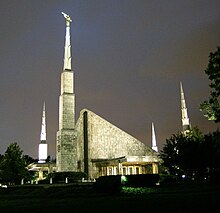
Dallas is a city in Texas and the most populous city in the Dallas–Fort Worth metroplex, the fourth-largest metropolitan area in the United States at 7.5 million people. It is the most populous city in and seat of Dallas County with portions extending into Collin, Denton, Kaufman, and Rockwall counties. With a 2020 census population of 1,304,379, it is the ninth-most populous city in the U.S. and the third-most populous city in Texas after Houston and San Antonio. Located in the North Texas region, the city of Dallas is the main core of the largest metropolitan area in the Southern United States and the largest inland metropolitan area in the U.S. that lacks any navigable link to the sea.

Frisco is a city in Collin and Denton counties in the U.S. state of Texas. It is part of the Dallas–Fort Worth metroplex and about 25 miles (40 km) from both Dallas Love Field and Dallas/Fort Worth International Airport. Its population was 200,509 in the 2020 U.S. census.
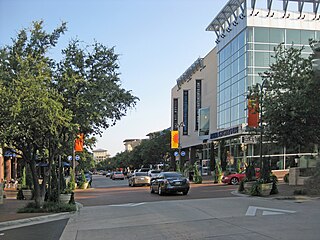
Plano is a city in the U.S. state of Texas. With a population of 285,494 at the 2020 census, it is the ninth most-populous city in Texas, and, respectively, the 72nd most populous city in the United States.
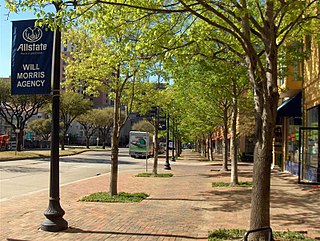
Las Colinas is a mixed-use planned community development in Irving, Texas, part of the Dallas/Fort Worth Metroplex, governed by The Las Colinas Association, a Texas non-profit corporation. Due to its central location between Dallas and Fort Worth and its proximity to Dallas/Fort Worth International Airport and Dallas Love Field airport, Las Colinas has been a focus of corporate and business relocation. It has many corporate office and retail spaces, luxury hotels, townhomes, single-family homes, private country clubs, gated enclaves, urban lofts, parks, landscaped water courses, and formerly its own light-rail transit system.
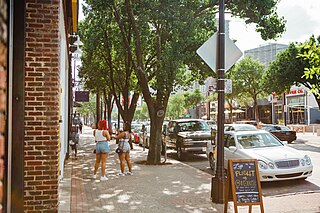
Deep Ellum is a neighborhood of Dallas, Texas, composed largely of arts and entertainment venues near downtown in East Dallas. Its name is based on a corruption of that of the area's principal thoroughfare, Elm Street. Older alternative uses include Deep Elm and Deep Elem.

The Dallas–Fort Worth metroplex, officially designated Dallas–Fort Worth–Arlington by the U.S. Office of Management and Budget, is a metropolitan statistical area in the U.S. state of Texas encompassing 11 counties. Its core cities are Dallas and Fort Worth. It is the economic and cultural hub of North Texas. Residents of the area also refer to it as DFW, or the Metroplex. The Dallas–Fort Worth–Arlington metropolitan statistical area's population was 7,637,387 according to the U.S. Census Bureau's 2020 census, making it the most populous metropolitan area in both Texas and the Southern United States, the fourth-largest in the U.S., and the tenth-largest in the Americas. In 2016, the Dallas–Fort Worth metroplex had the highest annual population growth in the United States.
Bryan Place is a neighborhood in Old East Dallas, Texas (USA). It is east of the Arts District of downtown and the State Thomas neighborhood, north of Deep Ellum, south of Cityplace and west of Munger Place. Its boundaries are generally considered to be US-75 North Central Expressway on the west, Ross Avenue on the (north)west, N. Washington Street on the (north)east, and Live Oak Avenue on the (south)east.

Old East Dallas is a community consisting of several neighborhoods in east Dallas, Texas, (USA). In 1890, the city was annexed into Dallas, making Dallas the largest city in Texas. Contrary to what its name implies, East Dallas is rich with culture both old and new; after the annexation, entrepreneurs and creatives occupied then shabby warehouses, turning them into clubs and venues, bringing culture and many social scenes that still thrive today in what is now Deep Ellum, among other neighborhoods of this district.
Dallas, Texas, United States, has a number of universities, colleges, schools and libraries.
Exposition Park is a neighborhood in south Dallas, Texas (USA). Centered along tree-lined Exposition Avenue, the small enclave stretches from the eastern edge of Deep Ellum to the entrance of Fair Park. The area includes Exposition Plaza, a one acre special use park established in 1984 that features an amphitheater and sculpture areas.
Temple Emanu-El of Dallas, Texas was the first Reform Jewish congregation in North Texas, and is the largest synagogue in the South.
Simon Sargon was a composer, pianist, conductor, music educator, and major creative figure in contemporary American Jewish music. His compositions include liturgical and secular pieces; opera and musical theatre; works for youth ensemble; choral and art song; and chamber ensemble and symphonic works.
Dallas is the second-largest city in Texas and has one of the largest Jewish communities in the state.
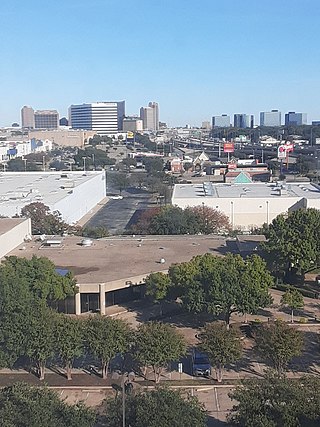
North Dallas is an area of numerous communities and neighborhoods in Dallas, Texas. The phrase "North Dallas" is also sometimes used to include any suburb or exurb north of Dallas proper within the metropolitan area. The majority of North Dallas is located in Dallas County, while a small portion is located in Collin and Denton counties. North Dallas generally includes areas of Dallas north of Northwest Highway, along with Lake Highlands and areas of Dallas north of IH-635 known as Far North Dallas. The area has strong social and economic ties to the Dallas enclave of Park Cities, and two inner suburbs of Dallas, Richardson and Addison.

Downtown Dallas is the central business district (CBD) of Dallas, Texas, United States, located in the geographic center of the city. It is the second-largest business district in the state of Texas. The area termed "Downtown" has traditionally been defined as bounded by the downtown freeway loop, bounded on the east by I-345 (although known and signed as the northern terminus of I-45 and the southern terminus of US 75, on the west by I-35E, on the south by I-30, and on the north by Woodall Rodgers Freeway.

Far North Dallas is the section of the city of Dallas, Texas which extends north of the Lyndon B. Johnson Freeway. Far North Dallas is part of North Dallas but is viewed as a distinct area. The area has strong social, economic, and political ties to two inner suburbs of Dallas, Richardson and Addison.
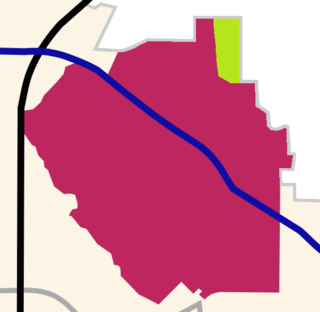
Whispering Hills is a neighborhood consisting of 615 homes within the Lake Highlands neighborhood of Dallas, Texas adjacent to the suburbs of Richardson and Garland. It is generally bounded by Buckingham Rd along the Richardson border to the north, to the east by the Garland border near Plano Rd, to the south by Walnut St, and to the west by the KCS Railroad and Audelia Branch Greenbelt near Audelia Rd.
Dallas–Fort Worth is the most populous metropolitan area of Texas, and the Southern United States. Having 7,637,387 residents at the 2020 U.S. census, the metropolitan statistical area has experienced positive growth trends since the former Dallas and Fort Worth metropolitan areas conurbated into the Metroplex. By the 2022 census estimates, its population grew to 7,943,685, and if the metropolis was consolidated into a single city, it would be the second-largest by population behind New York City.
The Dallas-Fort Worth (DFW) area has a population of Chinese Americans. In the second half of the 19th century, the area became permanently settled by non-Native Americans, and citizens of Chinese descent began to make the area their home as well. In modern times, the main population of Chinese Americans is scattered around the northern suburbs of the City of Dallas.
There is a significant population of American Muslims in the Dallas–Fort Worth metroplex. Dallas-Fort Worth is home to sixty-two Sunni mosques. According to AbdelRahman Murphy, a Chicago-born, Irving-based Islamic teacher and Muslim community leader, other U.S.-based Muslims now refer to Dallas as the "Medina of America". Not only is Dallas Masjid Al Islam the oldest Muslim community in the DFW area, it established the first mosque in the city of Dallas and established the first Muslim school in the DFW area. As of 2021, many major Muslim organizations and charities have headquarters or operations in DFW, mostly located in Richardson, Texas such as: ICNA Dallas, Muslim American Society, Muslim Legal Fund of America, Helping Hands for Relief & Development, Sabrina Memorial Foundation, Islamic Relief USA, CAIR-Texas, and MA’RUF. There are also several institutions of research and higher education such as: Qalam Institute (Carrollton), ISRA Foundation (Plano), Bayyina Academy (Euless), and The Islamic Seminary of America (Richardson). -



